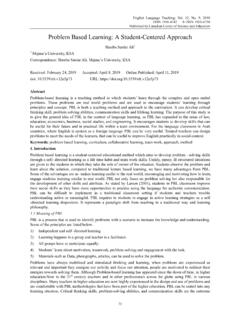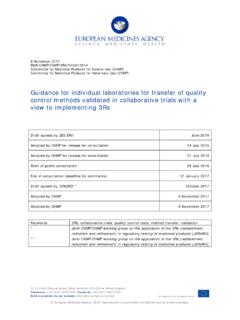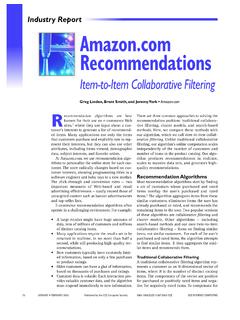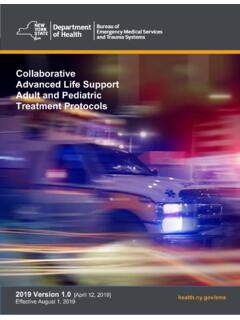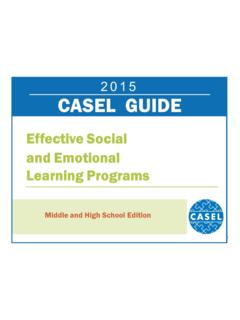Transcription of Values and Principles of the Reggio Emilia Approach
1 Values and Principles of the Reggio Emilia Approach Lella Gandini What are the distinguishing features of the education ported; it takes many forms and can help ensure the of young children with regard to theory and prac- welfare of all children in the program. tice that have made the Reggio Emilia Approach so The role of space: amiable schools. The infant/tod- notable? dler centers and preschools convey many messages, An examination of the features of this philosophy of which the most immediate is: this is a place soon reveals that the educators have been serious where adults have thought about the quality and the readers of John Dewey, Jean Piaget, Lev Vygotsky, instructive power of space.
2 The layout of physical David Hawkins, Jerome Bruner, Howard Gardner, space fosters encounters, communication, and rela- and other world-renowned scientists and philoso- tionships. Children learn a great deal in exchanges phers. In fact, Reggio educators have continued to and negotiations with their peers; therefore teach- keep abreast of the latest research in child develop- ers organize spaces that support the engagement of ment and education in other countries. At the same small groups. time, though, they continue to formulate new inter- Teachers and children as partners in learning.
3 Pretations and new hypotheses and ideas about learn- A strong image of the child has to correspond to a ing and teaching through their daily observations and strong image of the teacher. Teachers are not consid- practice of learning along with children. ered protective babysitters, teaching basic skills to The image of the child. All children have pre- children but, rather, they are seen as learners along paredness, potential, curiosity; they have interest with the children. They are supported, valued for in relationship, in constructing their own learning, their experience and their ideas, and seen as re- and in negotiating with everything the environment searchers.
4 Cooperation at all levels in the schools is brings to them. Children should be considered as the powerful mode of working that makes possible active citizens with rights, as contributing members, the achievement of the complex goals that Reggio with their families, of their local community. Chil- educators have set for themselves. dren with special rights (rather than using the term Not a pre-set curriculum but a process of inviting special needs) have precedence in becoming part of and sustaining learning. Once teachers have pre- an infant/toddler center or a preschool.
5 Pared an environment rich in materials and possibili- Children's relationships and interactions within ties, they observe and listen to the children in order a system. Education has to focus on each child, not to know how to proceed with their work. Teachers considered in isolation, but seen in relation with the use the understanding they gain thereby to act as family, with other children, with the teachers, with a resource for them. They ask questions and thus the environment of the school, with the community, discover the children's ideas, hypotheses, and theo- and with the wider society.
6 Each school is viewed as ries. They see learning not as a linear process but as a system in which all these relationships, which are a spiral progression and consider themselves to be all interconnected and reciprocal, are activated and partners in the process of learning. After observing supported. children in action, they compare, discuss, and inter- pret together with other teachers their observations, The role of parents. Parents are an essential com- recorded in different ways, to leave traces of what ponent of the program-a competent and active part has been observed.
7 They use their interpretations of their children's learning experience. They are not and discussions to make choices that they share with considered consumers but co-responsible partners. the children. Their right to participation is expected and sup- The power of documentation. Transcriptions of als and work of the atelier has entered into all the children's remarks and discussions, photographs of classrooms through the setting up of mini-ateliers, . their activity, and representations of their thinking as teachers and atelierista learn to work in very con- and learning are carefully studied.
8 These documents nected ways. have several functions. Most importantly, they help Projects. Projects provide the narrative and struc- to determine the direction in which the work and ture to the children's and teachers' learning experi- experiences with the children will go. Once these ences. They are based on the strong conviction that documents are organized and displayed, they help learning by doing is of great importance and that to make parents aware of their children's experience to discuss in groups and to revisit ideas and experi- and maintain their involvement.
9 They make it possi- ences is essential to gain better understanding and to ble for teachers to understand the children better and learn. Projects may start either from a chance event, to evaluate the teachers' own work, thus promoting an idea or a problem posed by one or more children, their professional growth; they make children aware or an experience initiated directly by teachers. They that their effort is valued; and furthermore, they cre- can last from a few days to several months. ate an archive that traces the history of the school.
10 Educators in Reggio Emilia have no intention of The many languages of children. Atelierista and suggesting that their program should be looked at as atelier. A teacher with a background in the visual a model to be copied in other countries; rather, they arts works closely with the other teachers and the consider their work as an educational experience that children in every preprimary school and visits the consists of reflection of theory, practice, and further infant/toddler centers. This teacher, who works in careful reflection in a program that is continuously a special workshop or studio known as an atelier, renewed and readjusted.



